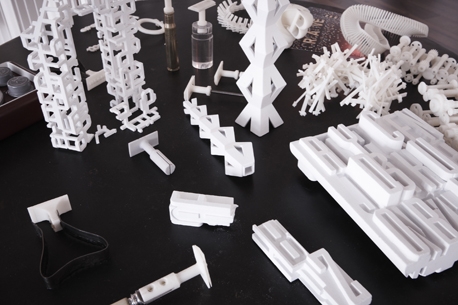FEATURE8 October 2013
All MRS websites use cookies to help us improve our services. Any data collected is anonymised. If you continue using this site without accepting cookies you may experience some performance issues. Read about our cookies here.
FEATURE8 October 2013
Technologies such as 3D printing are putting the means of production into the hands of the individual. So, asks Colin Strong: What might the rise of the Maker Movement mean for market research?

My dad was an engineer who had a remarkable appetite for making and fixing things. I remember our workshop was full of all manner of ‘projects’ in a state of repair and exploration, from oscilloscopes and radios through to washing machines – and, of course, a constant supply of toys that needed fixing.
Little did I know that years later my dad would be seen as a Maker, part of a movement that has been described by a Wharton economist, Jeremy Rifkin, “as significant as the shift from agriculture to the early industrial era”. The Maker Movement is essentially a grass-roots call for a return of the means of production to the hands of the individual. Evangelists such as Chris Anderson, author of Makers: The New Industrial Revolution, claim it has the potential to massively change our approach to manufacturing, via the same disruptive forces that have transformed many other industries.
The Maker Movement has three characteristics, according to Anderson:
The movement is in its early stages, perhaps similar to the early computing movement of the 1970s, where a legion of enthusiastic amateurs are pushing the boundaries of what is possible. There are now amazingly sophisticated tools available for self-production, such as 3D printers, laser cutters and 3D scanners, which are completely redefining what someone can create in their own backroom or garage. And indeed there is huge growth in ‘maker spaces’ – shared production facilities further reducing the barriers to entry for your very own manufacturing company. Of course, these tools do not provide any real economies of scale – it would be impossible to mirror the efficiency and cost effectiveness of large-scale production facilities as owned by the likes of Foxconn. So whilst large-scale manufacturing brands may see some profit erosion, it is unlikely to be fundamentally impacted by Makers.
It’s hard to predict with any precision, but arguably this is exactly the sort of issue that the research industry needs to be examining for threat and opportunity.
First and most obviously, market research could be supporting the growth in Maker companies, such as Arduino or DIY Drones, by identifying the types of niches that they could profitably fill. But there is also scope for market research to provide guidance for companies on the opportunities for creating the infrastructure for this movement. This is certainly a live issue for companies like Autodesk, which acquired Instructables, an online community of makers, or General Electric, which hosted GE Garages – temporary workspaces for Makers.
“As market researchers, we can use the very same tools that Makers use to develop and test prototypes. 3D design and printing significantly reduces the time between ideation and creation”

Colin Strong
Second, if the Maker Movement continues to gain traction we may well see the trend being reflected in a wider desire for individuals to put together their own proposition; to piece together something that suits their individual needs. To some extent, mass customisation is a reflection of this. Perhaps brands will increasingly disaggregate their propositions so that consumers can put them together in the way they want, in their own time.
Brands need to explore these opportunities – identifying the threats and opportunities of providing services in this way. It represents a fundamentally different relationship with consumers, but it’s perhaps one where there is the possibility for a much deeper and ongoing connection.
There are likely other broad implications, both for brands and for market research. Consumer expectations may start shifting towards smaller batches of production, reflecting the way in which Makers can fulfil niche demand. This is likely to be particularly the case in those categories that are most influenced by passing trends, such as the fashion industry. The clothing retailer Zara is an oft-referenced example of a company whose success depends on their ability to measure the demands of the market, design the appropriate garment, produce, ship and then sell it within a very short space of time. So rather than trying to predict a long way in advance what the options are, it becomes a matter of ‘measure and react’. By measuring the ‘zeitgeist’ for Makers, the market research industry can surely provide valuable support.
And of course, as with all open-source communities, there is an opportunity for market research companies to work with brands to spot ‘bottom-up’ innovation opportunities. Take the example of the Rocket Cup. Craig Kaplan, a computer science professor at the University of Waterloo, Canada, sent his Rocket Cup design to Shapeways, a company that 3D prints on demand as well as providing a marketplace to sell the resulting creations. Kaplan had produced the 3D ceramic cup as a tool for teaching students about paraboloids, but the sales on Shapeways caught the attention of gift company, Fred & Friends, who then bought the rights and put it into Urban Outfitters. By helping to spot the trends and opportunities on these open-source sites, market researchers can help link brands and Makers in a way that is mutually beneficial.
Last but not least, as market researchers, we can use the very same tools that Makers use to develop and test prototypes. At GfK, for example, we’ve used 3D modelling software to engage with consumers, working up detailed designs on screen in small focus groups. The on-screen, high quality images can be amended in real time to reflect the views of the group and then, importantly, the design can be directly outputted to a 3D printer. Whilst it lacks the look and feel of a professionally produced prototype, it significantly reduces the time period between ideation and creation.
Colin Strong is managing director of GfK Technology UK. For more on 3D printing and the Maker Movement, see Issue 3 of Impact Magazine, out this week.Main picture credit: Will Amlot
0 Comments